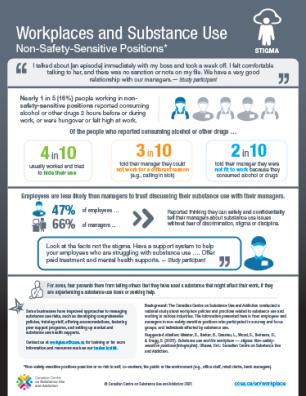Workplaces and Substance Use: Non–Safety-Sensitive Positions – Stigma
- Workplace
Featured Image
Image

Read this infographic
About this infographic
Illustrates key context and data on policies and training related to substance use by individuals in non–safety-sensitive positions (positions that pose low or no risk to self, co-workers, the public or the environment (e.g., office staff, retail clerks, bank managers). Information is based on input from a national study about workplace policies and practices related to substance use and working in various industries. This infographic is part of the Workplaces and Substance Use series.
Three key points of interest you will find in the document:
- About 5 in 10 managers reported policies or procedures exist on how to:
- intervene when a worker might be using alcohol or other drugs or be impaired,
- accommodate workers affected by alcohol or drug use issues, and
- manage workers who return to work after having left due to alcohol or drug use.
- Among 3 in 10 managers who reported that policies exist reported that they are not followed by employees and are not enforced by management.
- Information on how to obtain training to improve approaches on managing substance risks within an organization.
Related Authors
Shawna Meister, MA
Associate Director, Innovation and Evidence in Practice
Area of Expertise
- Impaired Driving
- Workplace
Related Publications
Workplaces and Substance Use: Non-Safety-Sensitive Positions
Workplaces and Substance Use: Non–Safety-Sensitive Positions – Workplace Culture
Workplaces and Substance Use: Non–Safety-Sensitive Positions – Use and Perceptions